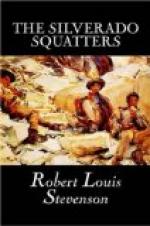For some way beyond Vallejo the railway led us through bald green pastures. On the west the rough highlands of Marin shut off the ocean; in the midst, in long, straggling, gleaming arms, the bay died out among the grass; there were few trees and few enclosures; the sun shone wide over open uplands, the displumed hills stood clear against the sky. But by-and-by these hills began to draw nearer on either hand, and first thicket and then wood began to clothe their sides; and soon we were away from all signs of the sea’s neighbourhood, mounting an inland, irrigated valley. A great variety of oaks stood, now severally, now in a becoming grove, among the fields and vineyards. The towns were compact, in about equal proportions, of bright, new wooden houses and great and growing forest trees; and the chapel bell on the engine sounded most festally that sunny Sunday, as we drew up at one green town after another, with the townsfolk trooping in their Sunday’s best to see the strangers, with the sun sparkling on the clean houses, and great domes of foliage humming overhead in the breeze.
This pleasant Napa Valley is, at its north end, blockaded by our mountain. There, at Calistoga, the railroad ceases, and the traveller who intends faring farther, to the Geysers or to the springs in Lake County, must cross the spurs of the mountain by stage. Thus, Mount Saint Helena is not only a summit, but a frontier; and, up to the time of writing, it has stayed the progress of the iron horse.
PART I—IN THE VALLEY
CHAPTER I—CALISTOGA
It is difficult for a European to imagine Calistoga, the whole place is so new, and of such an accidental pattern; the very name, I hear, was invented at a supper-party by the man who found the springs.
The railroad and the highway come up the valley about parallel to one another. The street of Calistoga joins the perpendicular to both—a wide street, with bright, clean, low houses, here and there a verandah over the sidewalk, here and there a horse-post, here and there lounging townsfolk. Other streets are marked out, and most likely named; for these towns in the New World begin with a firm resolve to grow larger, Washington and Broadway, and then First and Second, and so forth, being boldly plotted out as soon as the community indulges in a plan. But, in the meanwhile, all the life and most of the houses of Calistoga are concentrated upon that street between the railway station and the road. I never heard it called by any name, but I will hazard a guess that it is either Washington or Broadway. Here are the blacksmith’s, the chemist’s, the general merchant’s, and Kong Sam Kee, the Chinese laundryman’s; here, probably, is the office of the local paper (for the place has a paper—they all have papers); and here certainly is one of the hotels, Cheeseborough’s, whence the daring Foss, a man dear to legend, starts his horses for the Geysers.




